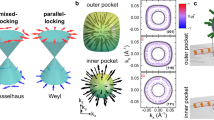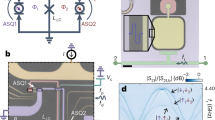Abstract
Strong coupling between light and elementary excitations is emerging as a powerful tool to engineer the properties of solid-state systems. Spin-correlated excitations that couple strongly to optical cavities promise control over collective quantum phenomena such as magnetic phase transitions, but their suitable electronic resonances are yet to be found. Here, we report strong light–matter coupling in NiPS3, a van der Waals antiferromagnet with highly correlated electronic degrees of freedom. A previously unobserved class of polaritonic quasiparticles emerges from the strong coupling between its spin-correlated excitons and the photons inside a microcavity. Detailed spectroscopic analysis in conjunction with a microscopic theory provides unique insights into the origin and interactions of these exotic magnetically coupled excitations. Our work introduces van der Waals magnets to the field of strong light–matter physics and provides a path towards the design and control of correlated electron systems via cavity quantum electrodynamics.
This is a preview of subscription content, access via your institution
Access options
Access Nature and 54 other Nature Portfolio journals
Get Nature+, our best-value online-access subscription
$29.99 / 30 days
cancel any time
Subscribe to this journal
Receive 12 print issues and online access
$259.00 per year
only $21.58 per issue
Buy this article
- Purchase on Springer Link
- Instant access to full article PDF
Prices may be subject to local taxes which are calculated during checkout




Similar content being viewed by others
Data availability
The main data sets generated and/or analysed during the current study are available at . All supplementary data will be provided by the corresponding authors upon reasonable request.
Change history
15 September 2022
In the version of this article initially published, the email address for Florian Dirnberger was missing the first letter "f"; the email has been amended in the html and PDF versions of the article.
References
Garcia-Vidal, F. J., Ciuti, C. & Ebbesen, T. W. Manipulating matter by strong coupling to vacuum fields. Science 373, eabd0336 (2021).
Basov, D., Fogler, M. & De Abajo, F. J. G. Polaritons in van der Waals materials. Science 354, 6309 (2016).
Deng, H., Haug, H. & Yamamoto, Y. Exciton–polariton Bose–Einstein condensation. Rev. Mod. Phys. 82, 1489 (2010).
Sanvitto, D. & Kéna-Cohen, S. The road towards polaritonic devices. Nat. Mater. 15, 1061–1073 (2016).
Sentef, M. A., Ruggenthaler, M. & Rubio, A. Cavity quantum-electrodynamical polaritonically enhanced electron–phonon coupling and its influence on superconductivity. Sci. Adv. 4, eaau6969 (2018).
Ashida, Y. et al. Quantum electrodynamic control of matter: cavity-enhanced ferroelectric phase transition. Phys. Rev. X 10, 041027 (2020).
Thomas, A. et al. Large enhancement of ferromagnetism under a collective strong coupling of YBCO nanoparticles. Nano Lett. 21, 4365–4370 (2021).
Gong, C. & Zhang, X. Two-dimensional magnetic crystals and emergent heterostructure devices. Science 363, 6428 (2019).
Liu, S. et al. Direct observation of magnon–phonon strong coupling in two-dimensional antiferromagnet at high magnetic fields. Phys. Rev. Lett. 127, 097401 (2021).
Kang, S. et al. Coherent many-body exciton in van der Waals antiferromagnet NiPS3. Nature 583, 785–789 (2020).
Hwangbo, K. et al. Highly anisotropic excitons and multiple phonon bound states in a van der Waals antiferromagnetic insulator. Nat. Nanotechnol. 16, 655–660 (2021).
Wang, X. et al. Spin-induced linear polarization of photoluminescence in antiferromagnetic van der Waals crystals. Nat. Mater. 20, 964–970 (2021).
Belvin, C. A. et al. Exciton-driven antiferromagnetic metal in a correlated van der Waals insulator. Nat. Commun. 12, 4837 (2021).
Sivadas, N., Daniels, M. W., Swendsen, R. H., Okamoto, S. & Xiao, D. Magnetic ground state of semiconducting transition-metal trichalcogenide monolayers. Phys. Rev. B 91, 235425 (2015).
Kim, S. Y. et al. Charge-spin correlation in van der Waals antiferromagnet NiPS3. Phys. Rev. Lett. 120, 136402 (2018).
Gnatchenko, S., Kachur, I., Piryatinskaya, V., Vysochanskii, Y. M. & Gurzan, M. Exciton–magnon structure of the optical absorption spectrum of antiferromagnetic MnPS3. Low. Temp. Phys. 37, 144–148 (2011).
Kudlacik, D. et al. Exciton and exciton–magnon photoluminescence in the antiferromagnet CuB2O4. Phys. Rev. B 102, 035128 (2020).
Tartakovskii, A. et al. Relaxation bottleneck and its suppression in semiconductor microcavities. Phys. Rev. B 62, R2283 (2000).
Virgili, T. et al. Ultrafast polariton relaxation dynamics in an organic semiconductor microcavity. Phys. Rev. B 83, 245309 (2011).
Kim, K. et al. Suppression of magnetic ordering in XXZ-type antiferromagnetic monolayer NiPS3. Nat. Commun. 10, 1–9 (2019).
Zasedatelev, A. V. et al. A room-temperature organic polariton transistor. Nat. Photonics 13, 378–383 (2019).
Gu, J. et al. Enhanced nonlinear interaction of polaritons via excitonic Rydberg states in monolayer WSe2. Nat. Commun. 12, 1–7 (2021).
Zhang, L. et al. Van der Waals heterostructure polaritons with moiré-induced nonlinearity. Nature 591, 61–65 (2021).
Afanasiev, D. et al. Controlling the anisotropy of a van der Waals antiferromagnet with light. Sci. Adv. 7, eabf3096 (2021).
Birowska, M., Junior, P. E. F., Fabian, J. & Kunstmann, J. Large exciton binding energies in MnPS3 as a case study of a van der Waals layered magnet. Phys. Rev. B 103, L121108 (2021).
Lane, C. & Zhu, J.-X. Thickness dependence of electronic structure and optical properties of a correlated van der waals antiferromagnetic NiPS3 thin film. Phys. Rev. B 102, 075124 (2020).
Jungwirth, T. et al. The multiple directions of antiferromagnetic spintronics. Nat. Phys. 14, 200–203 (2018).
Acknowledgements
We thank A. J. Millis, A. Punnoose, and X. Xu for useful discussions. Work at CUNY was supported through the NSF QII TAQS 1936276 (V.M.M., R.B.), the NSF CREST IDEALS center (V.M.M.), NSF DMR-2011738 (B.D.), and Army Research Office MURI grant W911NF-17-1-0312 (V.M.M. and A.H.M.). E.B. acknowledges support from the Robert A. Welch Foundation (grant F-2092-20220331). A.K. acknowledges support from a Graduate School Continuing Fellowship at the University of Texas at Austin. F.D. was funded by the Deutsche Forschungsgemeinschaft (DFG, German Research Foundation) through Projektnummer 451072703.
Author information
Authors and Affiliations
Contributions
V.M.M., E.B., F.D. and R.B. conceived the experimental idea and interpreted the results together with A.H.M. and A.K. F.D. and R.B. performed the experiments and conducted the data analysis with assistance from B.D. F.D. wrote the manuscript with input from all authors and V.M.M. supervised the project.
Corresponding authors
Ethics declarations
Competing interests
The authors declare no competing interests.
Peer review
Peer review information
Nature Nanotechnology thanks Alexey Kavokin and the other, anonymous, reviewer(s) for their contribution to the peer review of this work.
Additional information
Publisher’s note Springer Nature remains neutral with regard to jurisdictional claims in published maps and institutional affiliations.
Supplementary information
Supplementary information
Theoretical discussion and Supplementary Figs. 1–14.
Rights and permissions
Springer Nature or its licensor holds exclusive rights to this article under a publishing agreement with the author(s) or other rightsholder(s); author self-archiving of the accepted manuscript version of this article is solely governed by the terms of such publishing agreement and applicable law.
About this article
Cite this article
Dirnberger, F., Bushati, R., Datta, B. et al. Spin-correlated exciton–polaritons in a van der Waals magnet. Nat. Nanotechnol. 17, 1060–1064 (2022). https://doi.org/10.1038/s41565-022-01204-2
Received:
Accepted:
Published:
Issue Date:
DOI: https://doi.org/10.1038/s41565-022-01204-2
This article is cited by
-
Magnetically propagating Hund’s exciton in van der Waals antiferromagnet NiPS3
Nature Communications (2024)
-
Time-of-flight detection of terahertz phonon-polariton
Nature Communications (2024)
-
Controlling the magnetic state of the proximate quantum spin liquid α-RuCl3 with an optical cavity
npj Computational Materials (2023)
-
Magneto-optics in a van der Waals magnet tuned by self-hybridized polaritons
Nature (2023)
-
Magnetically-dressed CrSBr exciton-polaritons in ultrastrong coupling regime
Nature Communications (2023)



